乔姆斯基
- 格式:docx
- 大小:25.66 KB
- 文档页数:6
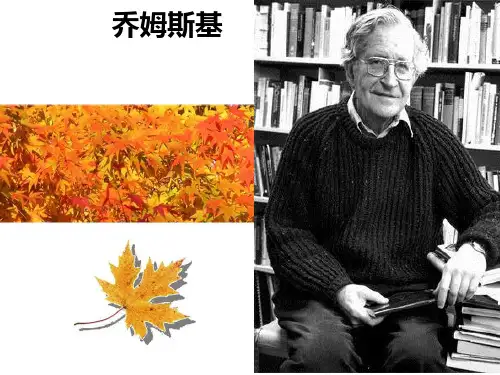
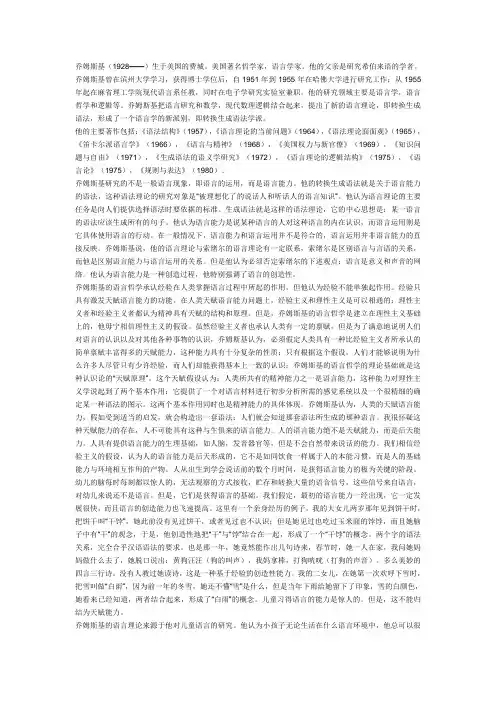
乔姆斯基(1928——)生于美国的费城。
美国著名哲学家,语言学家。
他的父亲是研究希伯来语的学者。
乔姆斯基曾在滨州大学学习,获得博士学位后,自1951年到1955年在哈佛大学进行研究工作;从1955年起在麻省理工学院现代语言系任教,同时在电子学研究实验室兼职。
他的研究领域主要是语言学,语言哲学和逻辑等。
乔姆斯基把语言研究和数学,现代数理逻辑结合起来,提出了新的语言理论,即转换生成语法,形成了一个语言学的新派别,即转换生成语法学派。
他的主要著作包括:《语法结构》(1957),《语言理论的当前问题》(1964),《语法理论面面观》(1965),《笛卡尔派语言学》(1966),《语言与精神》(1968),《美国权力与新官僚》(1969),《知识问题与自由》(1971),《生成语法的语义学研究》(1972),《语言理论的逻辑结构》(1975),《语言论》(1975),《规则与表达》(1980)。
乔姆斯基研究的不是一般语言现象,即语言的运用,而是语言能力。
他的转换生成语法就是关于语言能力的语法,这种语法理论的研究对象是“被理想化了的说话人和听话人的语言知识”。
他认为语言理论的主要任务是向人们提供选择语法时要依据的标准。
生成语法就是这样的语法理论,它的中心思想是:某一语言的语法应该生成所有的句子。
他认为语言能力是说某种语言的人对这种语言的内在认识,而语言运用则是它具体使用语言的行动。
在一般情况下,语言能力和语言运用并不是符合的,语言运用并非语言能力的直接反映。
乔姆斯基说,他的语言理论与索绪尔的语言理论有一定联系,索绪尔是区别语言与言语的关系,而他是区别语言能力与语言运用的关系。
但是他认为必须否定索绪尔的下述观点:语言是意义和声音的网络。
他认为语言能力是一种创造过程,他特别强调了语言的创造性。
乔姆斯基的语言哲学承认经验在人类掌握语言过程中所起的作用,但他认为经验不能单独起作用。
经验只具有激发天赋语言能力的功能。
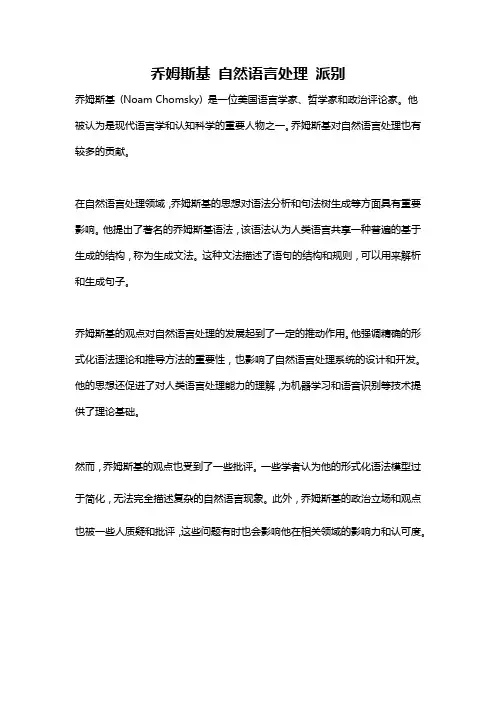
乔姆斯基自然语言处理派别
乔姆斯基(Noam Chomsky) 是一位美国语言学家、哲学家和政治评论家。
他被认为是现代语言学和认知科学的重要人物之一。
乔姆斯基对自然语言处理也有较多的贡献。
在自然语言处理领域,乔姆斯基的思想对语法分析和句法树生成等方面具有重要影响。
他提出了著名的乔姆斯基语法,该语法认为人类语言共享一种普遍的基于生成的结构,称为生成文法。
这种文法描述了语句的结构和规则,可以用来解析和生成句子。
乔姆斯基的观点对自然语言处理的发展起到了一定的推动作用。
他强调精确的形式化语法理论和推导方法的重要性,也影响了自然语言处理系统的设计和开发。
他的思想还促进了对人类语言处理能力的理解,为机器学习和语音识别等技术提供了理论基础。
然而,乔姆斯基的观点也受到了一些批评。
一些学者认为他的形式化语法模型过于简化,无法完全描述复杂的自然语言现象。
此外,乔姆斯基的政治立场和观点也被一些人质疑和批评,这些问题有时也会影响他在相关领域的影响力和认可度。
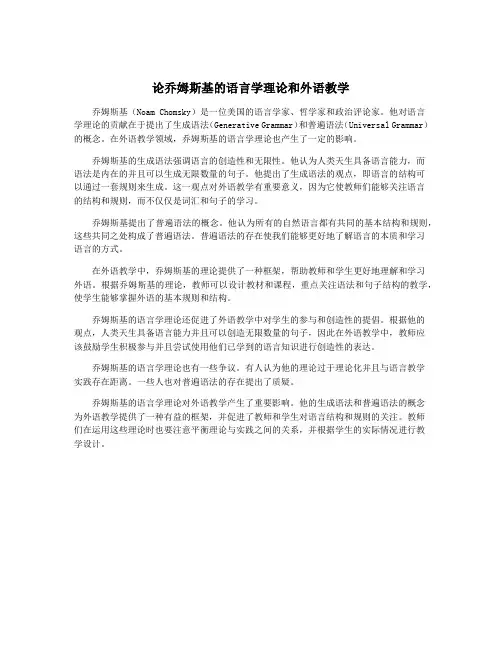
论乔姆斯基的语言学理论和外语教学乔姆斯基(Noam Chomsky)是一位美国的语言学家、哲学家和政治评论家。
他对语言学理论的贡献在于提出了生成语法(Generative Grammar)和普遍语法(Universal Grammar)的概念。
在外语教学领域,乔姆斯基的语言学理论也产生了一定的影响。
乔姆斯基的生成语法强调语言的创造性和无限性。
他认为人类天生具备语言能力,而语法是内在的并且可以生成无限数量的句子。
他提出了生成语法的观点,即语言的结构可以通过一套规则来生成。
这一观点对外语教学有重要意义,因为它使教师们能够关注语言的结构和规则,而不仅仅是词汇和句子的学习。
乔姆斯基提出了普遍语法的概念。
他认为所有的自然语言都有共同的基本结构和规则,这些共同之处构成了普遍语法。
普遍语法的存在使我们能够更好地了解语言的本质和学习语言的方式。
在外语教学中,乔姆斯基的理论提供了一种框架,帮助教师和学生更好地理解和学习外语。
根据乔姆斯基的理论,教师可以设计教材和课程,重点关注语法和句子结构的教学,使学生能够掌握外语的基本规则和结构。
乔姆斯基的语言学理论还促进了外语教学中对学生的参与和创造性的提倡。
根据他的观点,人类天生具备语言能力并且可以创造无限数量的句子,因此在外语教学中,教师应该鼓励学生积极参与并且尝试使用他们已学到的语言知识进行创造性的表达。
乔姆斯基的语言学理论也有一些争议。
有人认为他的理论过于理论化并且与语言教学实践存在距离。
一些人也对普遍语法的存在提出了质疑。
乔姆斯基的语言学理论对外语教学产生了重要影响。
他的生成语法和普遍语法的概念为外语教学提供了一种有益的框架,并促进了教师和学生对语言结构和规则的关注。
教师们在运用这些理论时也要注意平衡理论与实践之间的关系,并根据学生的实际情况进行教学设计。

乔姆斯基乔姆斯基政治观•乔姆斯基是美国激进派政治人物的代表之一,是反战、反媒体等社会运动的精神领袖。
•少年时代就参加左翼的共产主义运动,20世纪60年代越战期间投身校园反战运动,开始了“异见者”的一生,并被公认为美国政策“永远的反派”。
政治论著•American Power and the New Mandarins 1969•Vietnam: How Government Became Wolves 1972•The Crisis of Democracy 1977•U.S. Defense and Corporate Social Responsibility 1981···•《9·11》一书在2011年“9·11”事件发生当月上市。
这些论著涉及恐怖主义、种族主义、宗教、权利、自由、冷战、民族主义、无政府主义、市场经济、美国外交政策、帝国主义,知识分子的作用,传媒、社团等诸多领域。
他的种种观点都反映了无政府工团主义(anarchosyndicalism)、自由意志社会主义(Libertarian socialism)的思想。
他对帝国主义的批判、对自由市场价值的揭露、对媒体的质疑、对知识分子责任的阐述等等,都显示了他作为一个异见者对人们习以为常的事实的清醒判断,反映了他对真相的不懈追求。
乔姆斯基语言观和政治观的关联1、解释和异见在语言学领域他提出的生成语法打破了行为主义一统天下的局面。
他论证称世界上只有一种语言,语言本质上是我们的思维工具,I-语言(内化语言)不同于E-语言(外化语言),I-语言根植于我们的心智中,是人的生物属性,体现了人的心智特征。
在政治领域他致力于揭露现实。
许多我们认为显而易见的常识,在他看来并非正确无误。
例如我们以为媒体监督者当权者,而实际上媒体受着当局者的掌控。
除了对所谓正统的观念提出质疑外,乔姆斯基还致力于理解和解释为什么事实和常识存在着差距。

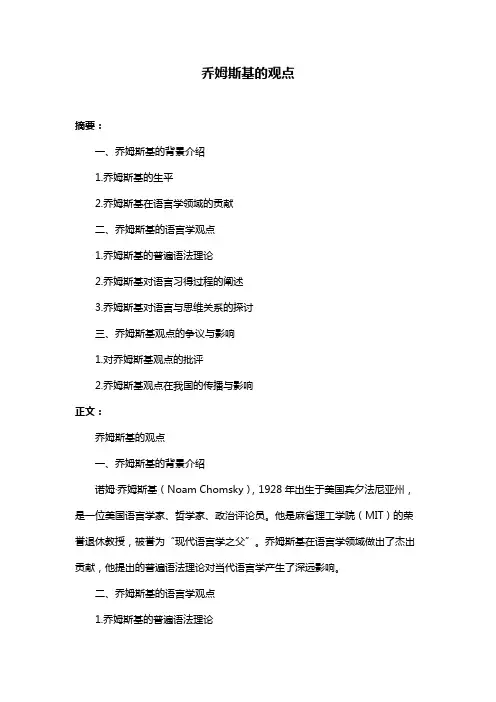
乔姆斯基的观点摘要:一、乔姆斯基的背景介绍1.乔姆斯基的生平2.乔姆斯基在语言学领域的贡献二、乔姆斯基的语言学观点1.乔姆斯基的普遍语法理论2.乔姆斯基对语言习得过程的阐述3.乔姆斯基对语言与思维关系的探讨三、乔姆斯基观点的争议与影响1.对乔姆斯基观点的批评2.乔姆斯基观点在我国的传播与影响正文:乔姆斯基的观点一、乔姆斯基的背景介绍诺姆·乔姆斯基(Noam Chomsky),1928年出生于美国宾夕法尼亚州,是一位美国语言学家、哲学家、政治评论员。
他是麻省理工学院(MIT)的荣誉退休教授,被誉为“现代语言学之父”。
乔姆斯基在语言学领域做出了杰出贡献,他提出的普遍语法理论对当代语言学产生了深远影响。
二、乔姆斯基的语言学观点1.乔姆斯基的普遍语法理论乔姆斯基最著名的理论是普遍语法理论,该理论认为人类的大脑天生具有一种普遍语法,这种语法是所有人类语言的基础。
普遍语法理论的核心观点是,人类语言具有共同的结构,这种结构可以通过儿童对语言的习得过程来理解。
2.乔姆斯基对语言习得过程的阐述乔姆斯基认为,儿童在接触语言的过程中,会形成一种语言习得机制。
这种机制使得儿童能够在有限的语言输入情况下,迅速掌握复杂的语言规则。
乔姆斯基将这一过程称为“语言天赋”。
3.乔姆斯基对语言与思维关系的探讨乔姆斯基认为,语言与思维之间存在密切关系。
语言不仅是人类表达思想和交流的工具,而且是人类思维的基础。
这种观点被称为“语言决定论”。
三、乔姆斯基观点的争议与影响1.对乔姆斯基观点的批评尽管乔姆斯基的观点在语言学领域产生了深远影响,但他的理论也受到了许多批评。
批评者认为,乔姆斯基的理论过于强调语言的先天性,忽视了语言习得过程中的社会和文化因素。
此外,一些实证研究也发现,儿童的语言习得过程并非如乔姆斯基所描述的那样简单。
2.乔姆斯基观点在我国的传播与影响乔姆斯基的观点在我国语言学界产生了广泛影响。
他的普遍语法理论为我国语言学者提供了新的研究视角,推动了中国语言学的发展。
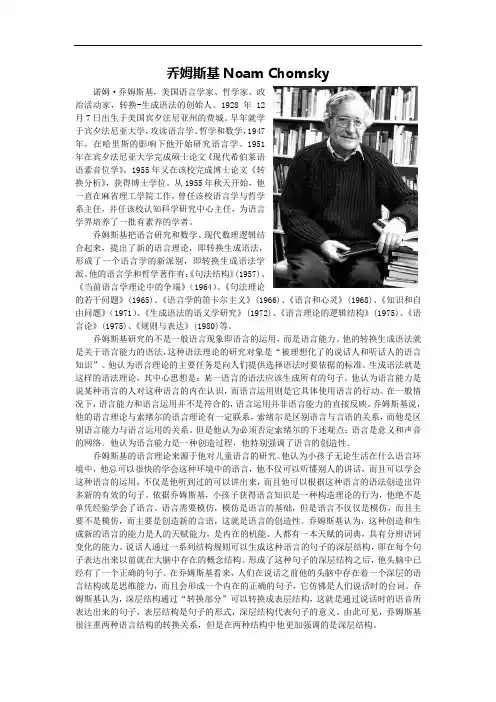
乔姆斯基Noam Chomsky诺姆·乔姆斯基,美国语言学家、哲学家、政治活动家,转换-生成语法的创始人。
1928年12月7日出生于美国宾夕法尼亚州的费城。
早年就学于宾夕法尼亚大学,攻读语言学、哲学和数学,1947年,在哈里斯的影响下他开始研究语言学。
1951年在宾夕法尼亚大学完成硕士论文《现代希伯莱语语素音位学》,1955年又在该校完成博士论文《转换分析》,获得博士学位。
从1955年秋天开始,他一直在麻省理工学院工作,曾任该校语言学与哲学系主任,并任该校认知科学研究中心主任,为语言学界培养了一批有素养的学者。
乔姆斯基把语言研究和数学、现代数理逻辑结合起来,提出了新的语言理论,即转换生成语法,形成了一个语言学的新派别,即转换生成语法学派。
他的语言学和哲学著作有:《句法结构》(1957)、《当前语言学理论中的争端》(1964)、《句法理论的若干问题》(1965)、《语言学的笛卡尔主义》(1966)、《语言和心灵》(1968)、《知识和自由问题》(1971)、《生成语法的语义学研究》(1972)、《语言理论的逻辑结构》(1975)、《语言论》(1975)、《规则与表达》(1980)等。
乔姆斯基研究的不是一般语言现象即语言的运用,而是语言能力。
他的转换生成语法就是关于语言能力的语法,这种语法理论的研究对象是“被理想化了的说话人和听话人的语言知识”。
他认为语言理论的主要任务是向人们提供选择语法时要依据的标准。
生成语法就是这样的语法理论,其中心思想是:某一语言的语法应该生成所有的句子。
他认为语言能力是说某种语言的人对这种语言的内在认识,而语言运用则是它具体使用语言的行动。
在一般情况下,语言能力和语言运用并不是符合的,语言运用并非语言能力的直接反映。
乔姆斯基说,他的语言理论与索绪尔的语言理论有一定联系,索绪尔是区别语言与言语的关系,而他是区别语言能力与语言运用的关系。
但是他认为必须否定索绪尔的下述观点:语言是意义和声音的网络。
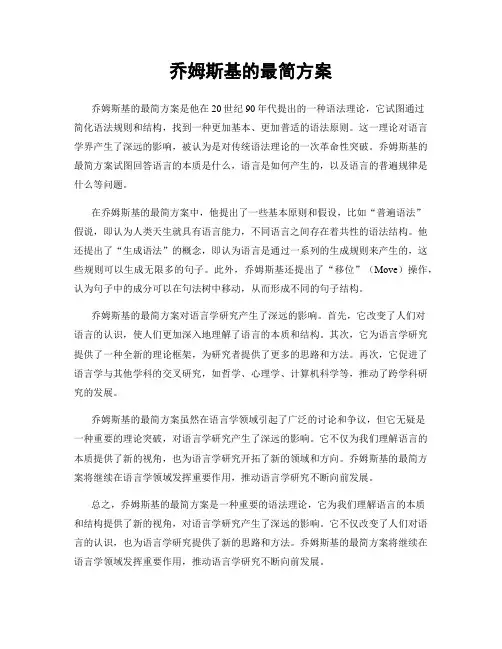
乔姆斯基的最简方案乔姆斯基的最简方案是他在20世纪90年代提出的一种语法理论,它试图通过简化语法规则和结构,找到一种更加基本、更加普适的语法原则。
这一理论对语言学界产生了深远的影响,被认为是对传统语法理论的一次革命性突破。
乔姆斯基的最简方案试图回答语言的本质是什么,语言是如何产生的,以及语言的普遍规律是什么等问题。
在乔姆斯基的最简方案中,他提出了一些基本原则和假设,比如“普遍语法”假说,即认为人类天生就具有语言能力,不同语言之间存在着共性的语法结构。
他还提出了“生成语法”的概念,即认为语言是通过一系列的生成规则来产生的,这些规则可以生成无限多的句子。
此外,乔姆斯基还提出了“移位”(Move)操作,认为句子中的成分可以在句法树中移动,从而形成不同的句子结构。
乔姆斯基的最简方案对语言学研究产生了深远的影响。
首先,它改变了人们对语言的认识,使人们更加深入地理解了语言的本质和结构。
其次,它为语言学研究提供了一种全新的理论框架,为研究者提供了更多的思路和方法。
再次,它促进了语言学与其他学科的交叉研究,如哲学、心理学、计算机科学等,推动了跨学科研究的发展。
乔姆斯基的最简方案虽然在语言学领域引起了广泛的讨论和争议,但它无疑是一种重要的理论突破,对语言学研究产生了深远的影响。
它不仅为我们理解语言的本质提供了新的视角,也为语言学研究开拓了新的领域和方向。
乔姆斯基的最简方案将继续在语言学领域发挥重要作用,推动语言学研究不断向前发展。
总之,乔姆斯基的最简方案是一种重要的语法理论,它为我们理解语言的本质和结构提供了新的视角,对语言学研究产生了深远的影响。
它不仅改变了人们对语言的认识,也为语言学研究提供了新的思路和方法。
乔姆斯基的最简方案将继续在语言学领域发挥重要作用,推动语言学研究不断向前发展。
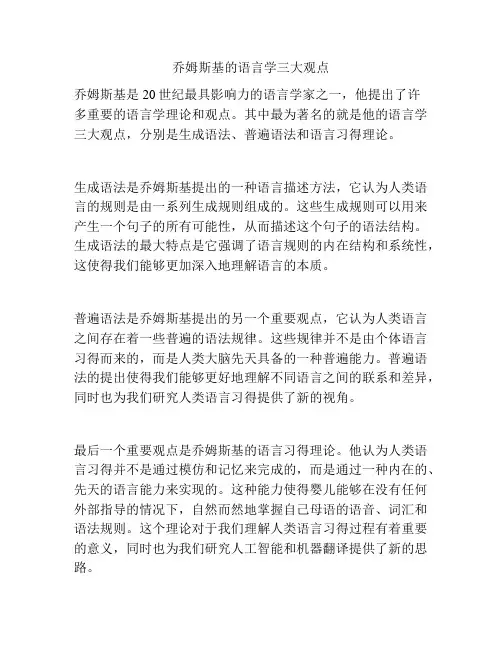
乔姆斯基的语言学三大观点
乔姆斯基是20世纪最具影响力的语言学家之一,他提出了许
多重要的语言学理论和观点。
其中最为著名的就是他的语言学三大观点,分别是生成语法、普遍语法和语言习得理论。
生成语法是乔姆斯基提出的一种语言描述方法,它认为人类语言的规则是由一系列生成规则组成的。
这些生成规则可以用来产生一个句子的所有可能性,从而描述这个句子的语法结构。
生成语法的最大特点是它强调了语言规则的内在结构和系统性,这使得我们能够更加深入地理解语言的本质。
普遍语法是乔姆斯基提出的另一个重要观点,它认为人类语言之间存在着一些普遍的语法规律。
这些规律并不是由个体语言习得而来的,而是人类大脑先天具备的一种普遍能力。
普遍语法的提出使得我们能够更好地理解不同语言之间的联系和差异,同时也为我们研究人类语言习得提供了新的视角。
最后一个重要观点是乔姆斯基的语言习得理论。
他认为人类语言习得并不是通过模仿和记忆来完成的,而是通过一种内在的、先天的语言能力来实现的。
这种能力使得婴儿能够在没有任何外部指导的情况下,自然而然地掌握自己母语的语音、词汇和语法规则。
这个理论对于我们理解人类语言习得过程有着重要的意义,同时也为我们研究人工智能和机器翻译提供了新的思路。
总之,乔姆斯基的三大语言学观点为我们深入理解人类语言本质提供了重要的理论支持。
这些观点不仅对于语言学界有着重要意义,同时也对于其他领域如人工智能、机器翻译等有着广泛的应用价值。

乔姆斯基(Noam Chomsky)语⾔习得理论乔姆斯基(Noam Chomsky, 1928--),美国语⾔学家,转换-⽣成语法的创始⼈。
1928年12⽉7⽇出⽣于美国宾⼣法尼亚州的费城。
1947年,在哈⾥斯的影响下他开始研究语⾔学。
1951年在宾⼣法尼亚⼤学完成硕⼠论⽂《现代希伯莱语语素⾳位学》,1955年⼜在该校完成博⼠论⽂《转换分析》,获得博⼠学位。
从1955年秋天开始,他⼀直在⿇省理⼯学院⼯作,曾任该校语⾔学与哲学系主任,并任该校认知科学研究中⼼主任,为语⾔学界培养了⼀批有素养的学者。
1 乔姆斯基的普遍语法理论 乔姆斯基在《语⾔与⼼智》⼀书中提出了“普遍语法”(Universal Grammar)的概念,以后简称为(UG)。
他假设⼉童⼀落⽣⼤脑⾥就存在⼀种独特的语⾔习得机制(Language AcquisitionDevice),以后简称LAD。
这种机制使得⼉童从周围听到有限的句⼦却能说出⽆限的句⼦。
他还提出⼀个语⾔习得的公式:最初的语⾔资料→LAD→语⾔能⼒。
乔姆斯基认为⼉童头脑中的LAD的主要组成部分是语⾔普遍特征,即普遍语法(UG)和⼀套评价系统。
⼉童听到外来语⾔后启动普遍语法,并在普遍语法的指导和控制下,在外来语⾔材料的基础上,通过假设——演绎的⽅法,在头脑中逐步形成有关母语的、系统的语法知识。
UG存在于⼈的⼤脑中,帮助⼈类习得语⾔,是⼈与⽣俱来的语⾔初始状态。
UG以第⼀语⾔习得速度快、知识准确、具有创造⼒等为依据研究第⼀语⾔。
乔姆斯基关于UG的假设为我们解释了为什么⼩孩⼦⼀⽣下来,⽤不了3-5年,不⽤接受系统的教育便已掌握了⾃⼰母语的主要特点。
UG是所有⼈类语⾔都遵循的⼀些共同原则和规则,但是如果语⾔知识仅仅是这些原则的话,那全世界的⼈就应该说同⼀种语⾔,但事实并⾮如此。
为了更合理的解释这⼀现象,就要应⽤到上⾯提到的评价系统。
也就是UG学说中的“原则和参数理论”(Principle and parameters in syntacticaltheory)。
乔姆斯基及其句法理论的若干问题评述乔姆斯基(Noam Chomsky)是现代语言学领域最重要的思想家之一,他对语言的研究对于认知科学、计算机科学以及人工智能等学科都有着深远的影响。
他提出的句法理论尤为著名,但同时也引发了许多争议。
本文将对乔姆斯基及其句法理论中的若干问题进行评述。
首先,乔姆斯基的句法理论假设语言具有普遍语法(Universal Grammar)的先天结构,即人类先天具备了一套基本的语法规则,这些规则在语言习得过程中起到了关键作用。
这一假设引发了对于“先天与后天”之间相互作用关系的争议。
一些学者认为乔姆斯基的观点过于强调语言的生物学基础,忽视了后天环境对语言习得和语言结构的影响。
其次,乔姆斯基的句法理论主张语言的生成式结构,即句子的结构是通过一系列生成规则一步一步地构建而成。
这种生成式方法在语言的形式和结构分析方面具有很大的价值,但也存在一些争议。
一些学者认为,这种生成式方法过于抽象和理论化,无法完全捕捉到实际语言使用中的复杂性和变化性。
另外,乔姆斯基的句法理论基于形式语言学的思想,将语言视为一种形式系统。
他认为语言表达可以通过形式化的规则进行分析和解释。
然而,有人质疑这种形式化的方法是否能够充分反映语言的真实使用情况,因为语言在不同的社会和文化背景中具有巨大的变异性和灵活性。
此外,乔姆斯基的句法理论也受到了实证研究的质疑。
一些学者认为,乔姆斯基的理论过于理论化,并缺乏实证研究的支持。
他们认为乔姆斯基的理论在试图解释语言结构时经常陷入圈套,无法提供实用的预测或解释。
然而,尽管乔姆斯基的句法理论存在一些问题和争议,但其对语言学和相关领域的贡献仍然不可忽视。
他的思想对于研究语言习得、语义理解以及计算机语言处理等方面都产生了深远的影响。
他提出的普遍语法概念也为语言研究提供了重要的理论基础。
总之,乔姆斯基及其句法理论在语言学界引发了广泛的讨论和争议。
其关于先天与后天、生成式结构、形式化方法以及实证研究的观点都有其争议性和局限性。
人类语言的层次结构乔姆斯基人类语言的层次结构乔姆斯基1. 介绍人类语言是人类最重要的交流工具之一。
通过语言,我们能够表达思想、分享知识、建立联系。
乔姆斯基(Noam Chomsky)是现代语言学领域的重要人物,他在20世纪的语言学理论中提出了一种关于人类语言的层次结构模型。
这个模型被称为乔姆斯基语法,它帮助我们理解语言的组成和语法的内部规则。
本文将深入探讨乔姆斯基语法的主要概念,以及它对我们理解人类语言的重要性。
2. 乔姆斯基语法的主要观点乔姆斯基语法的核心观点是,人类语言具有普遍语法结构,即所有人类语言都共享一些基本的语法规则。
这些规则被称为普遍语法原则,它们不是通过学习而获得的,而是与我们的大脑结构和基因相关联的。
乔姆斯基认为,这些普遍语法原则在人类语言的习得和使用中起着关键作用。
3. 乔姆斯基语法的层次结构乔姆斯基将语言的结构划分为不同的层次,分别是音素、词汇、句法和语义。
这些层次相互作用,构成了人类语言的层次结构。
3.1 音素层次音素是语言中的最小单位,它们是组成语言的声音元素。
每种语言都有一组特定的音素。
乔姆斯基认为,我们通过掌握不同的音素来区分不同的词语和句子,这是语言习得的第一步。
3.2 词汇层次词汇层次是语言的下一个层次。
它涉及到词汇的形成和组织方式。
我们通过学习词汇来理解和构建句子。
乔姆斯基认为,人类具有一种内在的能力,能够根据一些基础规则将词汇组织成无限多的句子。
3.3 句法层次句法层次是语言的核心层次,它关注句子的结构和语法规则。
通过句法规则,我们能够理解和产生各种各样的句子。
乔姆斯基认为,这种句法的能力是人类独有的,它是普遍语法原则的产物。
3.4 语义层次语义层次是语言的最高层次,它涉及到句子的意义和信息传递。
语义规则帮助我们理解和表达句子的意思。
乔姆斯基认为,语义规则也是由普遍语法原则所支配的。
4. 普遍语法原则的意义乔姆斯基的乔姆斯基语法对我们理解人类语言具有重要意义。
论乔姆斯基的语言学理论和外语教学引言在教学实践中,外语教学一直是备受关注的领域。
而要提高外语教学的效果,就必须深入了解语言的本质和规律。
在语言学领域,乔姆斯基被公认为是一位伟大的语言学家,他的语言学理论影响深远,对于外语教学也有着重要意义。
本文将就乔姆斯基的语言学理论和外语教学展开讨论,旨在探究其在外语教学中的应用和启示。
一、乔姆斯基的语言学理论1. 语言的本质和发展乔姆斯基认为语言是与生俱来的,是人类的一种本能,而非后天习得的技能。
他提出了语言习得的关键概念“语言习得装置(Language Acquisition Device, LAD)”,认为人类天生就具有一种语言习得的构造,这种构造使得儿童能够迅速而准确地习得母语。
乔姆斯基也提出了普遍语法理论,认为在所有自然语言中都存在着共同的语法原则。
这一理论对于外语教学也有着重要的影响,即在外语教学中应该尊重学习者的语言习得能力,重视语法的普遍性,而不是死记硬背、机械式地教授语言知识。
2. 语言的生成力乔姆斯基提出了生成语法理论,认为语言是由有限的元素生成无限的句子。
在他看来,句子的生成不是依赖于具体的句法规则,而是依赖于一套抽象的规则系统。
这一理论表明,语言具有无限的生成能力,这对于外语教学意味着学习者不仅要学会运用已有的语言知识,还要具备自己产生语言的能力。
在外语教学中,应该注重学生的语言创造力,培养他们独立运用语言的能力。
3. 语言能力和语言表现在乔姆斯基的语言学理论中,他区分了语言能力和语言表现两个概念。
语言能力是指人类对语言的普遍认知和掌握,而语言表现则是指这种能力在具体语言行为中的体现。
这一区分对于外语教学有着很大的启示意义,即教学不仅要关注学生的语言表现,更要重视学生的语言能力的培养。
外语教学应该注重对学生语言能力的培养,而不是仅仅追求他们的语言表现。
二、乔姆斯基的语言学理论对外语教学的启示1. 重视语言习得能力乔姆斯基的语言学理论认为语言是人类与生俱来的本能,这一观点对于外语教学提出了重要的启示。
一乔姆斯基的简介Avram Noam Chomsky is an American linguist, philosopher,[4][5]cognitive scientist, historian, and activist. He is an Institute Professor and Professor (Emeritus) in the Department of Linguistics & Philosophy at MIT, where he has worked for over 50 years. Chomsky has been described as the "father of modern linguistics" and a major figure of analytic philosophy. His work has influenced fields such as computer science, mathematics, and psychology.Chomsky is credited as the creator or co-creator of the Chomsky hierarchy, the universal grammar theory, and the Chomsky–Schützenberger theorem. Ideologically identifying with anarcho-syndicalism and libertarian socialism, Chomsky is known for his critiques of U.S. foreign policy[12]and contemporary capitalism,[13] and he has been described as a prominent cultural figure.[14] His media criticism has included Manufacturing Consent: The Political Economy of the Mass Media(1988), co-written with Edward S. Herman, an analysis articulating the propaganda model theory for examining the media.According to the Arts and Humanities Citation Index in 1992, Chomsky was cited as a source more often than any other living scholar from 1980 to 1992, and was the eighth most cited source overall. Chomsky is the author of over 100 books.二 1957年出版了《句法结构》Syntactic StructuresSyntactic Structures is a seminal book in linguistics by American linguist Noam Chomsky, first published in 1957. It laid the foundation of Chomsky's idea of transformational grammar. It contains the famous sentence, "Colorless green ideas sleep furiously", which Chomsky offered as an example of a sentence that is completely grammatical, yet completely nonsensical.In Syntactic Structures, Chomsky tries to construct a "formalized theory of linguistic structure" and places emphasis on "rigorous formulations" and "precisely constructed models".Justification of grammarsChomsky writes that his "fundamental concern" is "the problem of justification of grammars". He defines "a grammar of the language L" as "essentially a theory of L", as well as "a device that generates all of the grammatical sequences of L and none of the ungrammatical ones". Talking about the goals of linguistic theory, he draws parallels to theories in physical sciences. He compares a finite corpus of utterances of a particular language to "observations", grammatical rules to "laws" which are stated in terms of "hypothetical constructs" such as phonemes, phrases, etc.[15]According to Chomsky, the criteria for the "justification of grammars" are "external conditions of adequacy", "condition of generality" and "simplicity". To choose which is the best grammar for a given corpus of a given language, Chomsky shows his preference for the "evaluation procedure" (which chooses the best possible grammar for a languageagainst the aforementioned criteria) over the "discovery procedure" (a procedure employed in structural linguistics which is supposed to automatically produce the correct grammar of a language from a corpus) or the "decision procedure" (a procedure which is supposed to automatically choose the best grammar for a language from a set of competing grammars).[16][edit] GrammaticalityAccording to Chomsky, "the fundamental aim in the linguistic analysis of a language L is to separate the grammatical sequences which are the sentences of L from the ungrammatical sequences which are not sentences of L and to study the structure of the grammatical sequences."[17] By "grammatical" Chomsky means "acceptable to a native speaker".[17]Analyzing further about the basis of grammaticality, Chomsky shows three ways that do not determine whether a sentence is grammatical or not: its inclusion in a corpus, it being meaningful, and it being statistically probable. To illustrate his point, Chomsky presents a nonsensical sentence "Colorless green ideas sleep furiously"[6]and says that even though the sentence is grammatical, it is not included in any known corpus at the time and is neither meaningful nor statistically probable.Chomsky concludes that "grammar is autonomous and independent of meaning, and that probabilistic models give no particular insight into some of the basic problems of syntactic structure." [18][edit] Grammar modelsAssuming that a set of "grammatical" sentences of a language has been given, Chomsky then tries to figure out what sort of device or model gives an adequate account of this set of utterances. To this end, he first discusses finite state grammar, a communication theoretic model based on a conception of language as a Markov process. Then he discusses phrase structure grammar, a model based on immediate constituent analysis. He shows that both these models are inadequate for the purpose of linguistic description and as a solution, proposes his own formal theory of syntax called transformational generative grammar(TGG), "a more powerful model combining phrase structure and grammatical transformations that might remedy these inadequacies."[15]A transformational grammar has a "natural tripartite arrangement": phrase structure rules, transformational rules and morphophonemic rules.[19]The phrase structure rules are used for the expansion of grammatical categories and for substitutions. These yield a string of morphemes. A transformational rule "operates on a given string...with a given constituent structure and converts it into a new string with a new derived constituent structure."[20] It "may rearrange strings or may add or delete morphemes."[21]Transformational rules are of two kinds: obligatory or optional. Obligatory transformations applied on the "terminal strings" of the grammar produce the "kernel of the language",[19] which are simple, active, declarative and affirmative sentences. To produce passive, negative, interrogative or complex sentences, one or more optional transformation rules must be applied in a particular order to the kernel sentences. At the final stage of the grammar, morphophonemic rules convert a string of words into a string of phonemes.In Syntactic Structures, Chomsky invented the term "generative" and used it in a particular technical sense. When he says a finite set of rules "generate" the set of potentially infinite number of sentences of a particular human language, he means that they provide an explicit, structural description of those sentences.[22]三.Aspects of the Theory of Syntax(《句法理论的若干问题》)It is a book written by American linguist Noam Chomsky, first published in August 1965. It is known in linguistic circles simply as Aspects. Chomsky wrote Aspects to address the various deficiencies found in transformational generative grammar (TGG), a new kind of syntactic theory that he had introduced in the 1950s with the publication of his first book, Syntactic Structures. In Aspects, Chomsky presented a deeper, more extensive reformulation of TGG.The goal of linguistic theoryIn Aspects, Chomsky lays down the abstract, idealized context in which a linguistic theorist is supposed to perform his research: "Linguistic theory is concerned primarily with an ideal speaker-listener, in a completely homogeneous speech-community, who knows its language perfectly and is unaffected by such grammatically irrelevant conditions as memory limitations, distractions, shifts of attention and interest, and errors (random or characteristic) in applying his knowledge of the language in actual performance." He makes a "fundamental distinction between competence(the speaker-hearer's knowledge of his language) and performance (the actual use of language in concrete situation)." A "grammar of a language" is "a description of the ideal speaker-hearer's intrinsic competence", and this "underlying competence" is a "system of generative processes." An "adequate grammar" should capture the basic regularities and the productive nature of a language.[6]The structure of grammarChomsky summarizes his proposed structure of a grammar as follows: "A grammar contains a syntactic component, a semantic component and a phonological component...The syntactic component consists of a base and a transformational component. The base, in turn, consists of a categorial subcomponent and a lexicon. The base generates deep structures. A deep structure enters the semantic component and receives a semantic interpretation; it is mapped by transformational rules into a surface structure, which is then given a phonetic interpretation by the rules of the phonological component."[7]The addition of a semantic component to the grammar was the most important conceptual change since Syntactic Structures. Chomsky mentions that the semantic component is essentially the same as described in Katz and Postal (1964). Among the more technical innovations are the use of recursive phrase structure rules and the introduction of syntactic features in lexical entries to address the issue ofsubcategorization.Syntactic featuresIn Chapter 2 of Aspects, Chomsky discusses the problem of subcategorization of lexical categories and how this information should be captured in a generalized manner in the grammar. He deems that rewrite rules are not the appropriate device in this regard. As a solution, he borrows the idea of features from phonology. A lexical category such as noun, verb, etc. is represented by a symbol such as N, V. etc.A set of "subcategorization rules" then analyzes these symbols into "complex symbols", each complex symbol being a set of specified "syntactic features", grammatical properties with binary values.Syntactic feature is one of the most important technical innovations of the Aspects model. Most contemporary grammatical theories have preserved it.四transformational grammar or transformational-generative grammar(TGG) 的定义is a generative grammar, especially of a natural language, that has been developed in the Chomskyan tradition of phrase structure grammars (as opposed to dependency grammars). Additionally, transformational grammar is the tradition that gives rise to specific transformational grammars. Much current research in transformational grammar is inspired by Chomsky's Minimalist Program.[1]五 University grammar(普遍语法)定义Chomsky proved that language is entirely innate and discovered a "universal grammar" (UG). In fact, Chomsky simply observed that while a human baby and a kitten are both capable of inductive reasoning, if they are exposed to exactly the same linguistic data, the human child will always acquire the ability to understand and produce language, while the kitten will never acquire either ability. Chomsky labeled whatever the relevant capacity the human has which the cat lacks the "language acquisition device" (LAD) and suggested that one of the tasks for linguistics should be to figure out what the LAD is and what constraints it puts on the range of possible human languages. The universal features that would result from these constraints are often termed "universal grammar" or UG.[34]六,Language acquisition的定义Language acquisition is the process by which humans acquire the capacity to perceive and comprehend language, as well as to produce and use words to communicate.The capacity to successfully use language requires one to acquire a range of tools including syntax, phonetics, and an extensive vocabulary. This language might be vocalized as with speech or manual as in sign. The human language capacity is represented in the brain. Even though the human language capacity is finite, one can say and understand a infinite number of things.Evidence suggests that every individual has three recursive mechanisms that allows sentences to go indeterminately. These three mechanisms are: relativization, complementation and coordination.[1]Language acquisition usually refers to first language acquisition, which studies infants' acquisition of their native language. This is distinguished from second language acquisition, which deals with the acquisition (in both children and adults) of additional languages.The capacity to acquire and use language is a key aspect that distinguishes humans from other beings. Although it is difficult to pin down what aspects of language are uniquely human, there are a few design features that can be found in all known forms of human language, but that are missing from forms of animal communication.[2]For example, many animals are able to communicate with each other by signaling to the things around them, but this kind of communication lacks the arbitrariness of human vocabularies (in that there is nothing about the sound of the word "dog" that would hint at its meaning). Other forms of animal communication may utilize arbitrary sounds, but are unable to combine those sounds in different ways to create completely novel messages that are automatically understood by another. Hockett called this design feature of human language "productivity." It is crucial to the understanding of human language acquisition that we are not limited to a finite set of words, but rather must be able to understand and utilize a complex system that allows for an infinite number of possible messages. So, while many forms of animal communication exist, they differ from human languages in that they have a limited range of non-syntactically structured vocabulary tokens that lack cross cultural variation between groups.[3]A major question in understanding language acquisition is how these capacities are picked up by infants from what appears to be very little input. Input in the linguistic context is defined as "All words, contexts, and other forms of language to which a learner is exposed, relative to acquired proficiency in first or second languages" [4] It is difficult to believe, considering the hugely complex nature of human languages, and the relatively limited cognitive abilities of an infant, that infants are able to acquire most aspects of language without being explicitly taught. Children, within a few years of birth, understand the grammatical rules of their native language without being explicitly taught, as one learns grammar in school.[5]A range of theories of language acquisition have been proposed in order to explain this apparent problem. These theories include innatism and Psychological nativism in which a child is born prepared in some manner with these capacities, as opposed to other theories in which language is simply learned as one learns to ride a bike. The conflict betweenthe traits humans are born with and those that are a product of one's environment is often referred to as the "Nature vs. Nurture" debate. As is the case with many other human abilities and characteristics, it appears that there are some qualities of language acquisition that the human brain is automatically wired for (a "nature" component) and some that are shaped by the particular language environme nt in which a person is raised.。